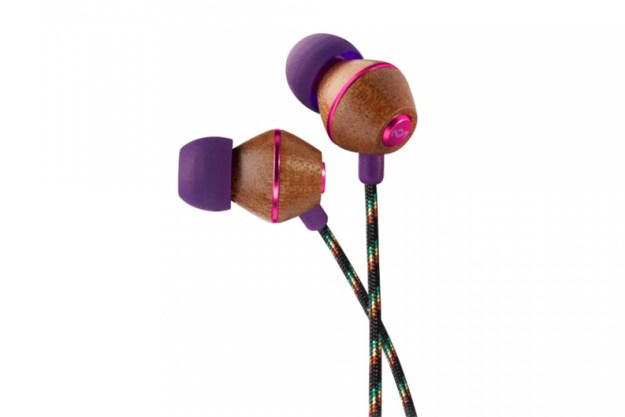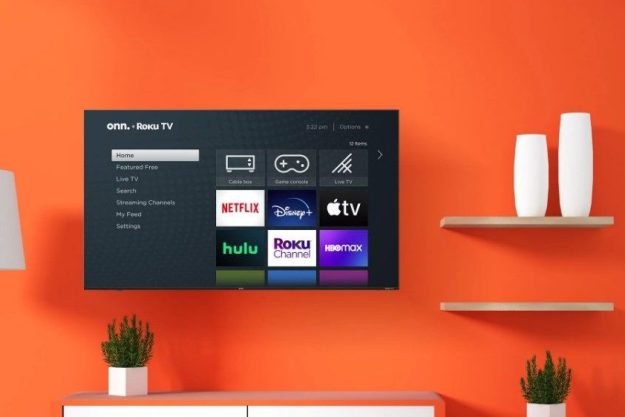
“… the PGR in-ears are, at their core, just another bass-heavy headset that acknowledges nothing else in the sound spectrum.”
- Powerful bass
- Eco-friendly construction and design
- Cloudy midrange
- Lack of presence in treble
- Devoid of detail
You don’t often hear a headphone maker describe its namesake as a “musical prophet”. But then again, there are few people who have touched the world of music – or culture as a whole – quite like Bob Marley. Marley’s electric personality and talent made him the unofficial worldwide ambassador of Reggae, ushering the genre to the masses with an uncanny merging of pop melodies, authentic musicianship, and an underlying message of revolution. Today, over 30 years after his death, he remains a cultural icon.
For a musical legend like no other, it’s perhaps fitting that the House of Marley People Get Ready (PGR) in-ear headphones are like no other set we’ve tested. Assembled from eco-friendly materials and laden with Rastafari colors, the headset looks more like a piece of jewelry you’d find at a hempfest than a piece of electronic equipment.
But apart from what you might glean from walking around said festival, Bob Marley didn’t get famous because of the way he dressed or the culture he inspired — it all started with the music. And while we love companies with an eye on environmental responsibility, our eternal question remains the same for the PGR as with any other headset we test: how do they sound? We sat down for a thorough sonic investigation to find out just that.
Out of the box
The People Get Ready headset comes in an earth-brown cardboard box made from recycled materials and covered top to bottom in earth-friendly messaging. Flipping back the magnetic cardboard flap on the front, we got our first glimpse of the wooden earbuds lying in a plastic inset beneath a cellophane window. Pulling the headphones from the box, we found some instructions and marketing material, 2 additional sizes of eartips, and a small cotton carrying pouch.

Features and design
Along with the headset maker’s economic participation with the Marley family’s charity, 1Love, the House of Marley PGR offers those with communal spirit some piece of mind in other ways. The earbuds’ bulbous housings are constructed from Forest Stewardship Council-certified wood and recyclable aluminum, among other environmentally friendly materials. Aside from the lighter global footprint and the unique aesthetic the components support, there exists the proposed sonic advantage of wood housings. Some manufacturers claim the wood provides a warmer midrange and a clearer overall tone, though we think driver compliment has a lot to do with the end result as well.
…we don’t recommend you listen to Bob Marley on them – or anything else for that matter.
The 52-inch braided headphone cable attaches to the earbuds via nimble plastic fixtures fastened to the bottom of the housings. A tiny L and R are just recognizable on the fixtures, making it difficult to differentiate which side is which without ample lighting. The fabric cable is black, checkered with multiple patterns of the familiar Rastafari red, green, and gold, and has a right-angled 3.5mm jack with gold plating.
The left and right sides of the cable connect at an iOS-compatible 3 button microphone assembly, which is black with silver accents. The microphone piece is longer than most we’ve seen, and though it worked well on phone calls, it was a serious offender of the dreaded “stethoscope effect”, creating a good deal of noise as it rubbed on our clothing.
Speaking of noise, the subject brings up a broader issue with the PGR as a whole. Though the “noise isolating” housings do a reputable job of blocking out ambient sound, they protrude quite a ways from the ear canal, and the wood construction is not at all adept at blocking wind. Any amount of air resistance, especially when bike riding, created an almost unbearable whistle in our ears — so much so that we had to pull the buds out after only a few minutes of riding — not exactly a selling point for those with an active lifestyle.
Comfort
The PGRs are fairly comfortable for a basic in-ear. The standard tips fit well, and we were able to wear the buds for extended listening periods with relative ease.
Audio performance
The House of Marley PGR sound the way you might expect earbuds housed in light, porous wood would sound. That is to say: they don’t quite convey pinpoint accuracy. On the contrary, the sound signature of the PGR is marked by a wide, booming low-end, a clouded midrange, and a severely truncated upper register.
These being Marley headphones, we thought it only fitting to begin our testing with our favorite Bob Marley album, Kaya. As soon as we cued up the title track, however, we knew we were headed for trouble. The normally subtle foundation of the keyboard bass line was completely overpowering right from its entry, utterly dominating the soundscape with heavy handed progressions. The powerful beat of the low end drowned out the subtle menagerie of the multiple percussion tracks and layered keyboards that help create the Wailers’ incredible sound. The instruments were scattered and choked, with many of the familiar nuances completely inaudible.
But the real issue came when Bob’s vocal entered. It sounded dingy, and pushed back, as if he were singing through a wall or on a bad microphone. All of his eclectic energy and tone were flat and squashed, masked by the bass and the blurry midrange. Even if the bass hadn’t been overpowering, it was clear as we listened on that the reproduction of the mid and upper frequencies was simply sub-par, unable to expound on complex productions with any semblance of clarity or balance.
As we moved on to other genres, the PGR consistently failed to deliver any real detail or definition in the upper register. Even when we served up softballs like the extremely clean and detailed eponymous album by Nickel Creek, the drivers fell short. The album, laden with the trio’s brilliantly captured acoustic instrumentation and vocal tracks, offered plenty of chances for some frequency solidarity. But instead, the sumptuous, breathy tones of Sarah Watkins’ vocals sounded as if they were sung through a plate of glass, while the stand-up bass walked all over the guitar, mandolin, and violin with an almost drunken impudence.
Conclusion
We applaud the earth-friendly efforts made by House of Marley. But aside from their unique, eco-conscious design, the PGR in-ears are, at their core, just another bass-heavy headset that acknowledges nothing else in the sound spectrum. For a price averaging around $30 online, the PGR does offer a lot of “bass for the buck”. But we think a Rastafari aesthetic makes a strange marriage with a groove pumper. And putting Bob Marley’s name on the box just feels like false advertising. If you want a headset that looks original and provides a bevy of bombastic bass, you can certainly check out the Marley People Get Ready in-ears. But we don’t recommend you listen to Bob Marley on them – or anything else for that matter.
Highs
- Powerful bass
- Eco-friendly construction and design
Lows
- Cloudy midrange
- Lack of presence in treble
- Devoid of detail
Editors' Recommendations
- House of Marley goes Lux with its revamped Stir it Up turntable
- House of Marley Redemption ANC 2 now available
- House of Marley’s new headphones look to provide ‘powerful sound with a purpose’
- House of Marley’s Champion: Sustainable, affordable true wireless earbuds
- House of Marley debuts $250 Exodus ANC, its first wireless ANC headphones




